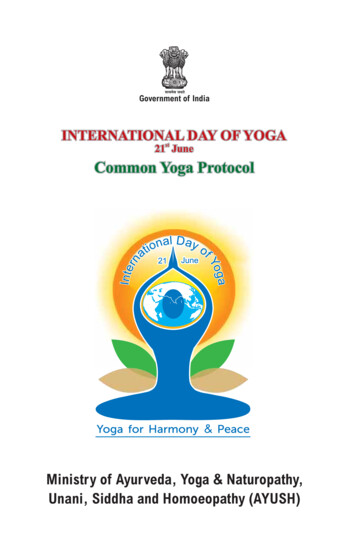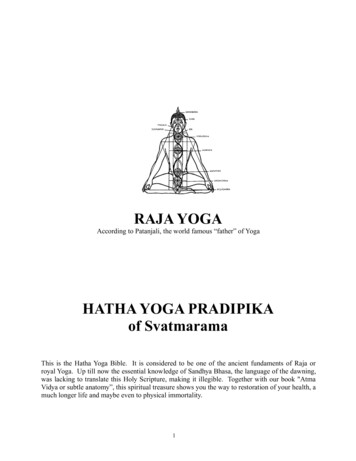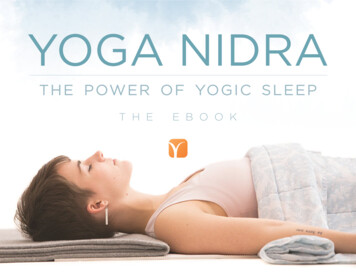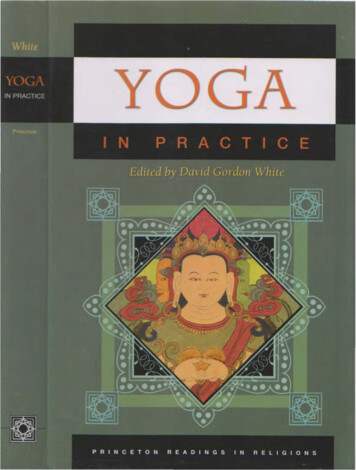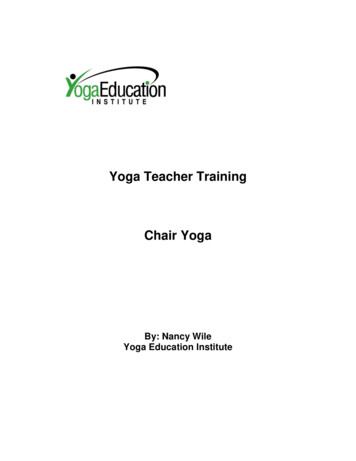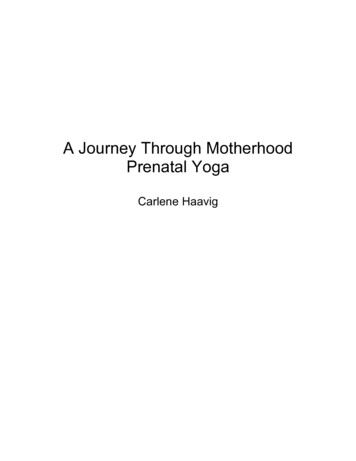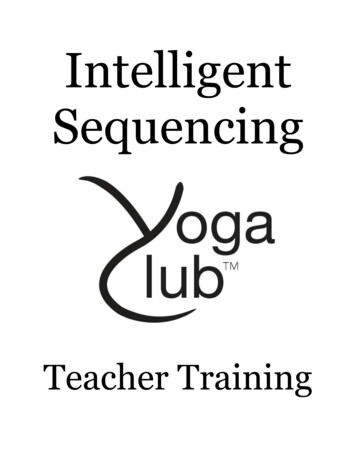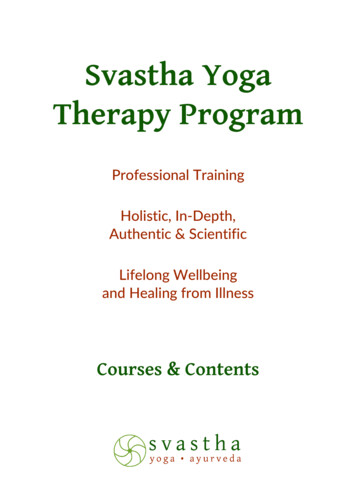
Transcription
Svastha YogaTherapy ProgramProfessional TrainingHolistic, In-Depth,Authentic & ScientificLifelong Wellbeingand Healing from IllnessCourses & Contents
CONTENTSTable of Courses & Hours . 1Foundations of Wellbeing & Yoga Therapy: Patterns & Holistic Change . 2Art & Science of Awareness: Mindfulness & Meditation. 3Rest, Rejuvenate & Feel Positive . 5Manage Your Emotions: Anger, Fear, Desire, Ego, Grief . 6Yoga of Speech: Words, Thoughts, Intention, & Instruction. 6Move Well: Master Course on Yoga Therapy for Locomotor Issues . 7Breathe Well: Master Course for Wellbeing & Yoga Therapy . 9Pranayamas of Classical Yoga. 10Keys of Hatha Yoga . 10Foundations of Ayurveda, Nutrition & Digestion, Lifestyle & Senses . 11Yogic Path to Better Relationships . 12Yoga Sutra & Samkhya: Yoga Psychology & Philosophy . 13Power of Mantra & Surya Namaskara . 13Yoga & Devotion . 14Disorder-Based Courses . 14Teaching Skills: Yoga Classes for Therapeutic Needs. 14Yoga for Anxiety, Trauma, Depression, Addictions & Stress . 15Chronic pain, pain syndromes, fibromyalgia . 16Respiratory and Cardiovascular disorders . 16Women’s health, menstrual disorders, menopause, pregnancy . 16Aging, Osteoporosis . 16Neurological disorders: stroke, Parkinson's disease, dementia . 17Immune system, inflammation, autoimmune diseases, hormones, endocrine disorders . 17Diabetes mellitus and metabolic syndromes . 17Yoga Therapy for Cancer. 17And more disorders . 17March 2022
Svastha Yoga Therapy ProgramCourses and ContentsTABLE OF COURSES & HOURSThis table lists the key courses of the 800-hour Svastha Yoga Therapy Program includinghours and classification. More electives will continue to be added. The rest of this documentoffers description of the contents of each course.234PROGRAMHRS DOMAINDomain-Based & Skill-Based Learning, including Traditional Frameworks & ScienceHabit &Foundations of Wellbeing & Yoga Therapy: Patterns & Holistic10ChangeChangeAwarenessArt & Science of Awareness: Meditation & Mindfulness30FeelingRest, Rejuvenate & Be Positive30FeelingManage Your Emotions: Anger, Fear, Desire, Ego, Grief305Yoga of Speech: Words, Thoughts, Intention & InstructionNo.19Move Well: Master Course on Yoga Therapy for LocomotorIssuesArt of Adaptation: Asana for EverybodyBreathe Well: Master Course for Wellbeing & Yoga TherapyPranayamas of Classical YogaKeys of Hatha YogaFoundations of Ayurveda, Nutrition & Digestion, Lifestyle &SensesYogic Path to Better RelationshipsYoga Sutra & Samkhya: Yoga Psychology & PhilosophyPower of Mantra & Surya NamaskaraYoga & DevotionMentoring & IntegrationOngoing Mentoring & Integration StreamPersonal MentoringDisorder-Based Yoga TherapyTeaching Skills: Yoga Classes for Therapeutic NeedsYoga For Anxiety, Trauma, Depression, Addictions & StressChronic Pain, Pain Syndromes, FibromyalgiaRespiratory And Cardiovascular DisordersWomen's Health, Menstrual Disorders, Menopause, PregnancyAging, OsteoporosisNeurological Disorders: Stroke, Parkinson's Disease, DementiaImmune System, Inflammation, Autoimmune Diseases,Hormones, Endocrine DisordersDiabetes Mellitus & Metabolic Syndromes10Journey of Cancer678910111213141512345678March 20221660163618303010302010Words ngNutrition,LifestyleRelationshipLife PathLife PathLife Path120301430816610612661
Svastha Yoga Therapy ProgramCourses and ContentsFOUNDATIONS OF WELLBEING & YOGA THERAPY: PATTERNS &HOLISTIC CHANGEDuration: 10 HoursThis course lays the foundation for understanding the traditional approach of yoga andayurveda toward wellbeing. Building on that, we then explore the practical ways to createsustainable positive transformation. The contents of this course are at the heart of all work asa yoga student, yoga facilitator and teacher of wellbeing, and as a yoga therapist.In this course, you will:1. Appreciate the holistic view of yoga and ayurveda.2. Explore wellbeing as the balance of functions in all levels of yourself.3. Use the full-spectrum Svastha map of wellbeing to look at the skills of wellbeing.4. Receive an introduction to assessing imbalance.5. Work with the ways to create, support, and sustain positive change.6. Understand conscious vs. unconscious in the yoga view: patterns and shifts.7. Appreciate the importance of the principle of adaptation—use it or lose it.8. Explore willpower, energy, resistance, effort as parameters that influence change.9. Differentiate stress vs. challenge. Cultivate safety, resilience. Understand coping andallostasis.10. Use curiosity, exploration, play, and the new vs familiar.11. Cognize the role of environment in change: supports for new patterns, triggers for oldpatterns.12. Choose steps in the journey of change: small steps and large steps.13. Adjust degree of challenge: less vs more in time and complexity.14. Manage lapses, trying again vs trying differently.15. Work with motivation: values, conviction, insight, changing vs. growing.16. Explore the personal meaning of change, value system, intrinsic and extrinsic rewards,changing vs. growing.17. Cultivating acceptance, balancing engagement and letting go.Traditional frameworks1. vṛtti-samskāra cycle.2. hetu, phala, āśraya, ālambana.3. śraddhā, vīrya, prajñā.4. tapas, svādhyāya, īśvara-praṇidhāna.5. vrata/vow/commitment.March 20222
Svastha Yoga Therapy ProgramCourses and ContentsART & SCIENCE OF AWARENESS: MINDFULNESS &MEDITATION30 HoursAwareness is the basis of conscious choice. Empowerment in self-care and wellbeing beginswith noticing our patterns. Starting from there, classical yoga presents the practices ofmindfulness, absorption, and contemplation expansively and in depth. In this master courseyou will understand, practice, and learn to teach these experiences of awareness to others—comprehensively, from yogic, modern, and practical perspectives.In this course, you will:1. Understanding the key types of awareness practices.2. Examine the ancient yoga frameworks that structure and explain awareness practices.3. Explore how we can use different types of awareness practices optimally on our journeyof wellbeing.4. Classify objects of awareness, what we can practice mindfulness or meditation on, basedon practical samkhya and yoga frameworks.5. Practice yogic mindfulness extensively and in-depth.6. Experience absorption practices in sight, mantra, breath and body, positive emotions andmore.7. Practice composite visualizations of sensations, images, and more.8. Explore the neuroscience of consciousness and attention.9. Understand the connections between yoga and modern positive psychology andneurobiology on the topic of meditation and mindfulness.Topics covered include:What and why of awareness practices1. The categories of directed attention: mindfulness, absorption, contemplation. What aretheir key features and the differences between them?2. The stages of progressive absorption in meditation practices.3. dhāraṇā, dhyāna, samādhi, samyama in traditional yoga.4. Ways that awareness practices play an important role in supporting holistic wellbeing andself-transformation: monitoring, focus, insight, goal-setting.5. Experiencing holistic states of change (bhāva).6. Recalling one’s attention (smṛti-sādhana).7. The arising and role of insight (prajñā) in transformation.8. What to meditate on? Objects or experiences of focus: body, breath, senses, emotions,abstractions, I-sense (grahītā, grahaṇā, grāhya).9. Contemplation and abstractions in meditation pathways: vikalpa, vitarka, vicāra.10. Awareness and the three guṇas of yoga as an underlying framework.March 20223
Svastha Yoga Therapy ProgramCourses and ContentsHow of awareness practices1. Balancing effort and relaxation in attention practices, walking the line between energyand dullness.2. Growing the qualities of steadiness and entrainment.3. Understanding and practicing focused vs. expansive awareness states.4. Managing the emotional background of mindfulness and absorptive states.5. Cultivating a stable meditation pathway over time.6. Finding salience or importance in objects of absorption.Yogic mindfulness: cultivating sattvic presence1. Understanding the cautions, challenges, recommendations in mindfulness practices.2. Developing and deepening sattvic mindfulness of breath, body, senses, thoughts andemotions.Yogic absorption: foundations of mantra, imagery and moreUnderstand the principles of, and practice absorption in:1. sound, mantra, speech.2. light, images.3. breath and body sensation.4. positive emotions.5. peace, stillness.Science of consciousness and attentionUnderstand the neuroscience of the self, including:1. emergence and purpose of self-construct.2. nerve signaling, neural circuits.3. theories of consciousness.4. top-down monitoring and feedback systems.Explore the neurobiology of:1. mindfulness, absorption.2. flow states, default mode network.3. mystic and alternative consciousness states.Traditional yoga frameworks1. bhāva2. dhāraṇā, dhyāna, samādhi, smṛti-sādhana3. prajñā4. vikalpa, vitarka, vicāra5. grahītā, grahaṇā, grāhyaMarch 20224
Svastha Yoga Therapy ProgramCourses and ContentsREST, REJUVENATE & FEEL POSITIVE30 HoursMany of us are overwhelmed in modern life. We struggle to manage our energy, find rest,and bring positive feelings to our mind and body. This program will give you the knowledge,practice, and skills to balance your energy levels, find deep rest and restoration, and cultivatepositive emotions and sensations of compassion, joy, gratitude, and more. You will learnancient wisdom underpinning these topics in yoga, explore modern and practical applications,and develop your teaching skills.In summary, in this course, you will: Learn to balance your energy levels from being low or high to a neutral and functionalstate. Understand and practice rest, deep rest, and restoration. Cultivate positive emotions and sensations in mind and body including compassion, love,joy, and gratitude. Develop teaching skills for all the above.Topics include:Balancing energy1. Understanding emotion, valence, energy, and the connection to the yogic frameworks ofguna-s and klesa-s.2. Winding down from high energy: using your body, breath, senses to recover balance.How to meet high energy level where it is and chart multimodal stepdown.3. Activating from low energy: using your body, breath, senses to recover. How to meet lowenergy level where it is and chart multimodal step up.Cultivating deep rest and recoveryWorking with:1. safety and letting go.2. support and release.3. mobilization and ease.4. visualization for relaxation.5. surrendering effort. and more techniques of deep rest.Cultivating positive emotions1. Exploring the role and importance of positive emotions in wellbeing.2. Understanding the traditional presentation of positive emotions in yoga.3. Growing compassion, joy, love, gratitude and more.4. Understanding the challenges in cultivating positive emotions.5. Working with therapeutic applications of positive emotion practices.March 20225
Svastha Yoga Therapy ProgramCourses and ContentsTraditional Frameworks3 guṇa-s, bhāva, maitrī, karuṇā, mudita, upekṣā, santoṣa.Modern ScienceUnderstanding the stress response and its role in activation, regulation, and shut down:1. sympathetic nervous system, activation, mobilization responses.2. parasympathetic nervous system, relaxation, immobilization responses3. polyvagal theory, heart rate variability4. window of tolerance, resilienceMANAGE YOUR EMOTIONS: ANGER, FEAR, DESIRE, EGO, GRIEF30 HoursThis is an on-demand course available on Svastha Yoga Online.Please click here for course d-emotionsYOGA OF SPEECH: WORDS, THOUGHTS, INTENTION, &INSTRUCTION15 HoursWords create our story. Our inner narrative shapes our responses to life events. If we canchange our inner dialogue toward ourselves and others, and the speech that arises from thatinner dialogue, we will have great power to rewrite our choices.How can we understand the role that our inner story plays in our lives? How do we rewritethat inner story? How do we manage our negative thoughts and create positive ones? Canwe change our speech? We will explore, practice, and teach all this and more in this course.In summary, in this course, you will:1. Understand inner cognition through words and appreciate the difference betweenthoughts and reality.2. Learn to manage negative thoughts and cultivate positive intentions and thoughts.3. Experience how speech arises from thoughts and practice mindful speech.4. Develop skills of listening and learn how to use supportive dialogue.5. Understand and apply the basics of cognitive therapy, motivational interviewing, andtrauma sensitive language.Topics include:Understanding cognition through words1. Appreciating the role of our inner story and how it frames our life events.2. Understanding the necessity of concepts and abstractions.March 20226
Svastha Yoga Therapy ProgramCourses and Contents3. Exploring the difference between inner reality vs. outer reality.Managing negative thoughts1. Learning to observe negative thoughts with mindfulness.2. Challenging and reframing negative thoughts skillfully.3. Exploring the basic concepts and frameworks of cognitive therapy.4. Reflecting on traditional yogic approach to cognitive framing.Cultivating positive intentions and thoughts1. Learning to frame positive intentions skillfully.2. Developing a stepwise pathway to increasing positive thoughts.3. Understanding the limits of positive thinking and the problems of toxic positivity.Managing speech and dialogue1. Experiencing how speech arises from thoughts, from intention to expression.2. Developing skills of active listening and holding the space for others to expressthemselves.3. Offering non-judgmental and supportive dialogue.4. Understanding the keys of motivational interviewing.5. Learning the basics of safety in dialogue through trauma sensitive language.Traditional Frameworks1. pramāṇa, viparyaya, vikalpa, smṛti2. parā, paśyantī, madhyamā, vaikarī3. mantra as wordsMOVE WELL: MASTER COURSE ON YOGA THERAPY FORLOCOMOTOR ISSUES60 HoursThis course will take you through all the important skills of movement for each region of thebody, the major disorders that arise in those regions, and the yoga therapy approach tomanaging them. These same skills are also what keep your locomotor system healthy andhelp you move well, lifelong.In summary, in this course, you will:1. Learn the locomotor skills needed to move well.2. Receive guided exercises, observation and assessment, and teaching practice for thoseskills.3. Understand the necessary functional anatomy of key body regions.4. Learn decision pathways to work with imbalances of these body regions.5. Appreciate the implication of major locomotor system disorders and diagnoses and learnhow to approach them.March 20227
Svastha Yoga Therapy ProgramCourses and Contents6. Understand safety and contraindications along with each skill and disorder-basedmanagement.Topics include:1. Understanding, practicing, and teaching the skills of moving well:a. pain-management as neededb. awareness & explorationc. relaxation, released. mobilization, easing movemente. stability, controlf.strength, enduranceg. range of movement, stretchingh. alignment for safe and effective force transmission and loadingi.balance, gaitj.agility, speed and responsivenessk. coordination, increasing complexityl.positive emotion and supportive dialogue toward the bodym. breathing to support moving welln. play, exploration, intrinsic reward2. Learning and teaching guided exercises for each of these regions to develop importantmovement skills, with a holistic focus:a. low backb. mid & upper backc. neckd. shouldere. elbow, wrist & handf.sacrumg. hiph. kneei.ankle & foot3. Learning and teaching guided practices combining multiple movement skills for a regionand across regions.4. Appreciating safety and contraindications in teaching and practice.5. Observing a student, assessing locomotor imbalances, and working with decisionpathways or protocols for managing those imbalances.6. Working with major locomotor disorders such as:a. lumbar spine (chronic low back pain, disc herniation, sciatica, facet joint dysfunction,hyperlordosis, spondylolisthesis)b. thoracic spine (hyperkyphosis, stiffness, facet joint dysfunction)c. cervical spine (head forward alignment, disc herniation, nerve compression)d. scoliosisMarch 20228
Svastha Yoga Therapy ProgramCourses and Contentse. shoulder (impingement, rotator cuff tears, instability)f.elbow, hand (epicondylitis, carpal tunnel syndrome)g. sacroiliac pain and dysfunctionh. hip (fracture, alignment, soft tissue imbalances)i.knee (IT band, meniscal tears, ligament strains)j.dropped arches, hallux valgus7. Understanding the tissues of the locomotor system: fascia, cartilage, bones, muscles,ligaments, joints, nerves.8. Appreciating the global organization of movement: tension, compression, tensegrity andintegration; prediction, feedback, neural control; development of movement.9. Understanding the science of key locomotor skills.BREATHE WELL: MASTER COURSE FOR WELLBEING & YOGATHERAPY40 HoursThis master course covers the keys of breathing well: skills, practices, wisdom, insights, andscience.In summary, in this course, you will:1. Learn the skills needed to breathe well, lifelong.2. Receive guided exercises, observation and assessment, and teaching practice for thoseskills.3. Understand the necessary functional anatomy of breathing techniques.4. Learn decision pathways to work with imbalances of the breath.5. Understand safety and contraindications of different breathing skills.Topics include:1. Charting the parameters of breathing.2. Observing the breath as it is.3. Finding comfort with the natural breath and understanding its uses.4. Regulating the cycle of breathing skillfully.5. Managing the effort of breathing: decreasing the effort of breathing with ease, increasingthe effort with arousal.6. Working with deep breathing and shallow breathing.7. Understanding the anatomy, principles, and practice of physical patterns of breathing andtheir uses, including abdominal breathing, lower rib breathing, upper chest breathing, andbreathing into the back.8. Appreciating the connection between breath and body movement and its practical uses.9. Lengthening the breath with care and comfort.10. Safely using fast breathing.March 20229
Svastha Yoga Therapy ProgramCourses and Contents11. Cultivating the inhalation: including using movement, position, touch, visualization, sound,and sequencing.12. Cultivating the exhalation: including using movement, position, touch, visualization,sound, and sequencing.13. Developing breath suspension, safety, contraindications, benefits, sequencing and more.14. Using breathing ratios and stepped breathing in asana and pranayama.15. Using ujjāyī breathing in asana.16. Working with sound to enhance breathing.Traditional Frameworks1. prāṇa, deśa, kāla, saṁkhyā, dīrgha, sūkṣma2. sama-vṛtti, viṣama-vṛtti, vairambhaModern Science1. Functional anatomy of the respiratory system.2. Functional anatomy of breathing cycle.3. Physiology of respiration, including:a. control of breathingb. gas exchange and transportc. energy generationd. metabolic impact, acid-base balancee. hyperventilation and hypoventilation4. Introduction to visceral regulation and breathing:a. interoception, homeostasisb. vagal tone, heart rate variability, regulation through breathc. connections based on polyvagal theoryPRANAYAMAS OF CLASSICAL YOGA18 HoursThis is an on-demand course available on Svastha Yoga Online.Please click here for course mas-of-classical-yogaKEYS OF HATHA YOGA30 HoursThis course takes you on a profound journey into the knowledge, frameworks, insights, andpractices of ancient haṭha-yoga. It offers you a different and deeply insightful pathway tounderstand body, breath, and life energy, and how they related to your mind and senses.March 202210
Svastha Yoga Therapy ProgramCourses and ContentsThis course will clarify and elucidate complex areas of classical hatha yoga such as prāṇa,nāḍī, cakra, mudra, bandha, agni and more. You will also explore the teachings ofKrishnamacharya on these areas, including his approach to asana. You will also be guided inpractices using body, breath, rituals, visualizations, and more, to connect with the experiencesbehind these concepts.Topics include:1. Understanding various aspects of prāṇa from the ancient texts.2. Examining the theory of the traditional pathways of yoga: rāja, haṭha, laya, nāda.3. Exploring and connecting with the subtle body through the practice of inner touch withthe breath.4. Learning and practicing the key prāṇa-bhāvana-s (visualizations or inner experiences withprāṇa).5. Examining the system of nāḍī-s from classical teachings and their relevance in practice.6. Analyzing the pathway of the cakra systems from classical teachings, and the ways theymay be used (physical, conceptual, meditational, devotional).7. Explore sensible practices based on the cakra-s.8. Understanding the theory of the bandha-s and mudra-s in haṭha-yoga.9. Systematically practicing the bandha-s with preparation, balancing, and safety. Applyingthe practice of the bandha-s and mudras for various purposes: physical, therapeutic,absorptive.10. Understanding the concept and role of multiple agni-s in yoga (as compared to ayurveda),and how to use them in physical practice, meditation, and spiritual transformation.11. Learning the traditional frameworks of asana, sequencing, balancing, and more in theteachings of Krishnamacharya: krama-s, vinyāsa, pratikriyā, āsana-jaya and more.FOUNDATIONS OF AYURVEDA, NUTRITION & DIGESTION,LIFESTYLE & SENSES30 HoursThis course gives you a solid foundation in the traditional approach of ayurveda, as relevantto wellbeing maintenance, nutrition, and yoga therapy. We will explore the skills of healthfuleating and developing a nourishing relationship to food. We will also go into the topics oflifestyle management, sleep management, and taking care of the senses. Further, we alsocover digestive disorders and the yoga and ayurveda approach to managing them.In summary, in this course, you will:1. Learn the foundations of ayurveda for health maintenance and wellbeing direct from theancient traditional sources, and made accessible and clear.2. Understand the importance of nutrition and be guided in developing strategies foroptimizing relationship to food and diet.3. Examine and implement lifestyle management of sleep, energy, daily activity, fasting,exercise, and sensory management for greater wellbeing from a traditional and modernscientific perspective.March 202211
Svastha Yoga Therapy ProgramCourses and ContentsTopics include:1. Exploring the roots and key frameworks of ayurveda from the traditional sources, clearlyand effectively, including:a. guṇa and kriya: qualities and functions of body and mind.b. three doṣa-s (vāta pitta kapha) and their divisions.c. seven dhātu-s.d. agni and āma.2. Understanding and assessing ayurvedic constitution (prakṛti) and observing individualbalance and imbalance (vikṛti).3. Learning common patterns of imbalance of the functions of the doṣa-s and measures tobalance them.4. Exploring the impact of daily life routine (dinacarya) and adaption to the seasons orenvironment (ṛtucarya) from the traditional ayurvedic perspective.5. Following the models of kāla, artha, karma, hīna-, ati-, and mithyā-yoga, andprajñāparādha, to analyze imbalances of senses and actions and bring them back towellbeing.6. Developing daily routine and rituals and personalizing lifestyle. Balancing work, play, rest.7. Reflecting on and developing pathways for adapting to stages of life.8. Taking care of the eyes and ears and managing what we see and hear.9. Appreciating the importance of sleep, the science behind it, and developing better qualityand duration of sleep holistically.10. Examining the physiology of the digestive system as relevant to holistic wellbeing andyoga therapy.11. Exploring the complexity of the science of nutrition, the microbiome, and commonapproaches to diets in the modern era.12. Charting diet and eating patterns.13. Understanding relationship to food and hunger (nourishment, sensation, craving, coping).14. Cultivating beneficial relationships to food, before, during, and after eating.15. Investigating the importance of fasting, its relevance, safety, and strategies to practice iteffectively.16. Understanding major digestive disorders from a modern medical perspective, as well astaking an ayurvedic and yogic approach to managing them.YOGIC PATH TO BETTER RELATIONSHIPS10 hoursRelationships are a key ingredient of good life quality. Humans are not meant to live inisolation. We depend on relationships from birth until our passing to provide us with support,connection, stability, positive emotions, meaning, and much more. In this course, we willexplore the yogic frameworks, reflections, and practices that can help us nurture supportive,safe, and beneficial relationships in our lives.March 202212
Svastha Yoga Therapy ProgramCourses and ContentsIn this course, you will:1. Appreciate the role of connection in wellbeing.2. Learn to take a holistic approach to navigating relationships.3. Understand common archetypes from the ancient perspectives in a modern context:parent-child, spouse, friend, teacher-student, therapist-client etc.4. Explore how ethics and boundaries are key to safe and stable relationships.5. Appreciate how positive intentions and emotions are a foundation for rewardingconnection.6. Examine real-life case studies of relationships problems and strategies to manage them.7. Be guided through reflections, practices, and teaching skills on all the above topics.Traditional FrameworksTypes of sambandha, adhyāsa, yama-s and niyama-s.YOGA SUTRA & SAMKHYA: YOGA PSYCHOLOGY & PHILOSOPHY30 HoursThis flagship course presents the core psychological and philosophical theory, frameworks,and insights of Samkhya and Yoga. Presented by the Mohans, with impeccable authenticity,exceptional depth, and precise clarity, this course encapsulates the teachings of Patanjali, theesteemed commentator Vyasa and the key yogis from thereon.Samkhya and yoga philosophy and psychology are grouped and organized by concepts andframeworks in this offering. The entire wisdom of these ancient texts is made accessible in astructure that students can follow in modern times, without compromising their integrity.In this course, you will:1. Learn all the important frameworks of Samkhya and Yoga.2. Understand these ancient systems by concepts and frameworks, so you see theirrelationships clearly and concisely.3. Be connected directly to the classical sources, so that you are completely confident inwhat you are learning.4. Explore how these teachings are related to wellbeing.POWER OF MANTRA & SURYA NAMASKARA20 HoursThe classical practice of mantra is used extensively in Vedic traditions and plays a key role inyoga too. Mantra has profound transformative and therapeutic power when used wisely. Theconnection to the sun, and the ancient meditation, mantra, and visualization practicesassociated with that fall under the heading of surya-namaskara. This course will help youunderstand the theory, wisdom, and insights of these deep and often confusing topics withclarity and effectiveness. You will also be guided in practices that help you experience thevalue of mantra and surya-namaskara for wellbeing and yoga therapy.March 202213
Svastha Yoga Therapy ProgramCourses and ContentsIn this course, you will:1. Dive into the theory and knowledge of mantra meditation: what is mantra, why do n
Svastha Yoga Therapy Program Courses and Contents March 2022 7 3. Exploring the difference between inner reality vs. outer reality. Managing negative thoughts 1. Learning to observe negative thoughts with mindfulness. 2. Challenging and reframing negative thoughts skillfully. 3. Exploring the basic concepts and frameworks of cognitive therapy. 4.
